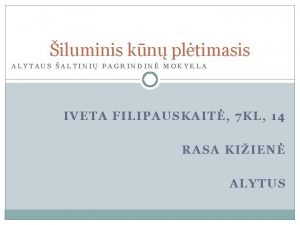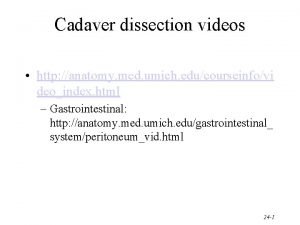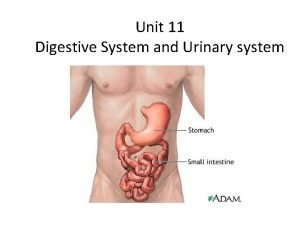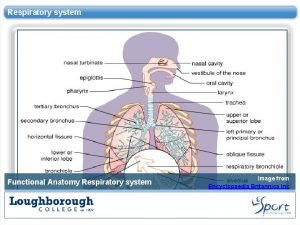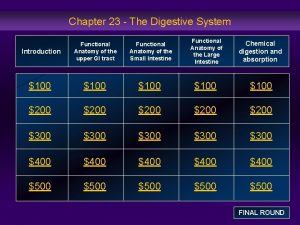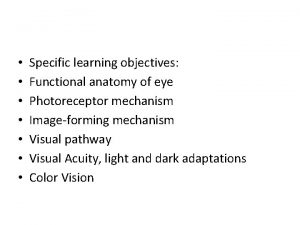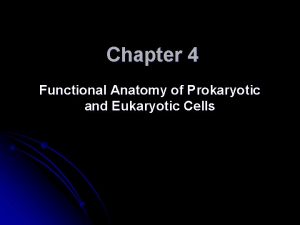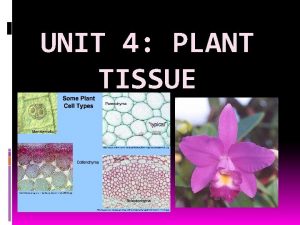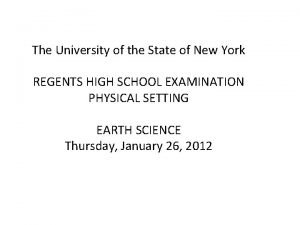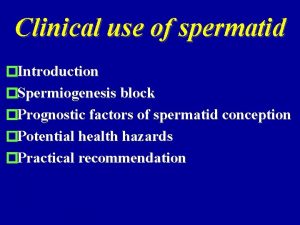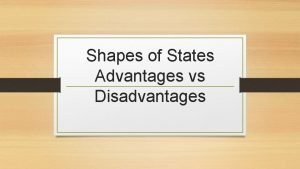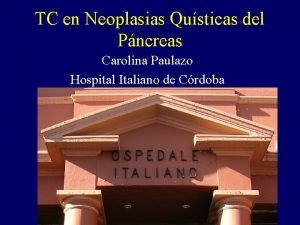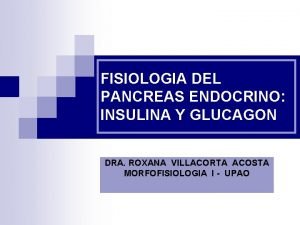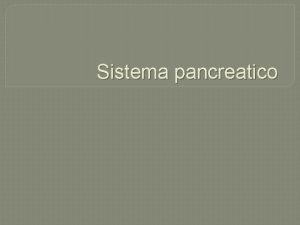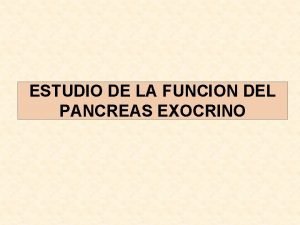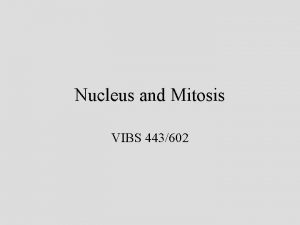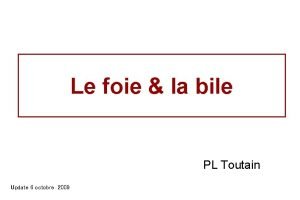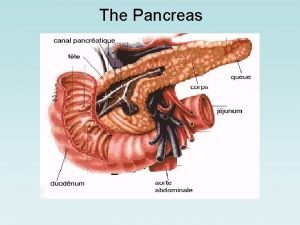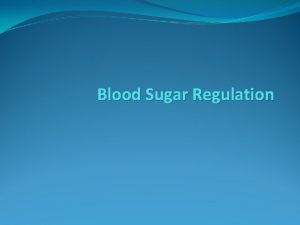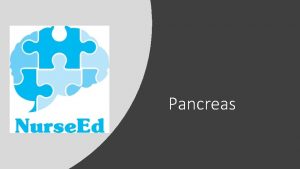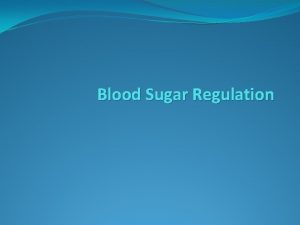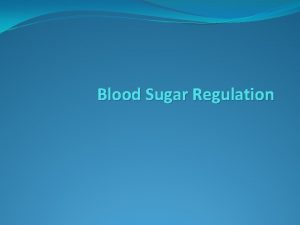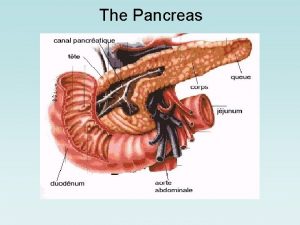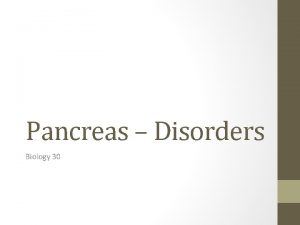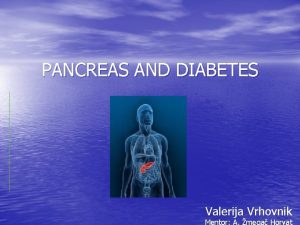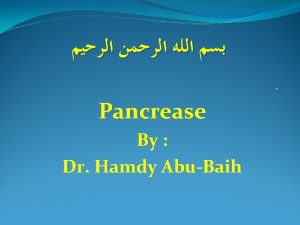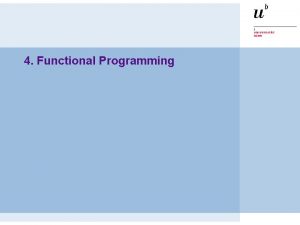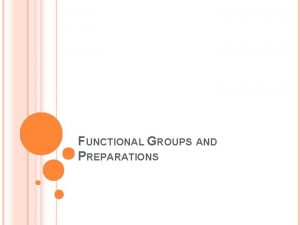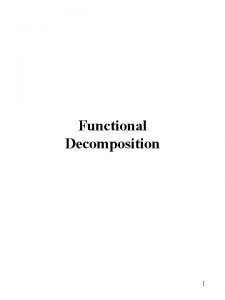PANCREAS Dr Indu K PANCREAS Functional anatomy Elongated

































- Slides: 33

PANCREAS Dr Indu K

PANCREAS Functional anatomy Elongated gland Retroperitoneal Anatomically 4 parts – Head, Neck , Body & Tail. Physiologically – 2 parts Exocrine – pancreatic juice Endocrine – 4 hormones

FUNCTIONAL ANATOMY

STRUCTURAL CHARACTERISTICS OF EXOCRINE PART OF PANCREAS Acinar cells Produce secretions containing enzymes. Larger ducts from acinar cells & smaller ductules produce SODIUM BICARBONATE solution.

HISTOLOGY

PANCREATIC DUCTS Main pancreatic duct – (Duct of Wirsung) runs from tail to head, join common bile duct to form Ampulla of Vater which is guarded by Sphincter of Oddi. The enzymes and sod bicarbonate enters into this duct.

PANCREATIC DUCTS Accessory pancreatic duct (Duct of Santorini) runs from head to minor papilla above main duct.

NERVE SUPPLY Parasympathetic : - Vagus Nerve to acinar cells. On stimulation, it causes secretion of pancreatic enzymes. Sympathetic : - Splanchnic Nerve. On stimulation, it causes inhibition of pancreatic secretion. Reflexes : - Gastropancreatic reflex and Vagovagal reflex. They are mediated by intrinsic nerve plexus ( E. N. S. )

PANCREATIC JUICE Properties Transparent , isotonic , colorless. 1200 -1500 ml/day. Sp gravity – 1. 010 to 1. 018 Highly alkaline. ( Help to neutralize gastric acid in duodenum. otherwise it leads to duodenal ulcer. )

CHARACTERISTICS OF SECRETION Secretion by acinar cells – isotonic & resembles plasma. Secretion by intralobular ductal cells – has high conc of K+& HCO 3 Secretion by extralobular ductal cells – stimulated by secretin, rich in HCO 3 Modification in main collecting duct – as secretion moves in main duct water moves into duct & makes secretion isotonic & HCO 3 - moves out of duct for Cl-

MECHANISM OF PANCREATIC SECRETION Secretion of pancreatic enzymes – from acinar cells Formation of aqueous component of pancreatic secretion – by columnar epithelial cells.

MECHANISM OF BICARBONATE SECRETION

MECHANISM OF BICARBONATE SECRETION In smaller ducts of Pancreas there is a higher conc of HCO 3 but as the juice moves forward water is added and ultimately the pancreatic juice becomes isotonic with respect to plasma and also alkaline. This bicarbonate neutralizes the acidity of gastric chyme in duodenum.

PANCREATIC JUICE Composition – 99. 5% water, 0. 05% solids Organic mainly enzymes, amylase, protease, lipase & trypsin inhibitor Inorganic – Na+, K+, Ca+, Mg+, Zn+& HCO 3 - secreted in response to chyme in duodenum.

PANCREATIC ENZYMES Pancreatic α amylase – for digesting carbohydrate ( same as salivary amylase) Hydrolyses glycogen, starch except cellulose. Lipolytic enzymes – it includes pancreatic lipase, cholesterol ester hydrolase, & phospholipase A 2. Pancreatic lipase hydrolyses neutral fat into monoglycerides & FA. Cholesterol ester hydrolase converts cholesterol ester to cholesterol.

PANCREATIC ENZYMES Pancreatic proteases – for digestion of proteins Trypsin Chymotrypsin. Proelastase Procarboxypeptidase A & B.

TRYPSIN Trypsinogen Enterokinase Trypsin Hydrolyses proteins to proteoses & Polypeptides.

CHYMOTRYPSIN. Chymotrypsinogen Trypsin Chymotrypsin

ELASTASE Proelastase Elastase Trypsin Digest Elastin

TRYPSIN INHIBITOR. The inactive enzymes get activated only after entering the intestinal tract. Trypsin inhibitor prevents their activation in the pancreas. Thus it protects autodigestion of pancreas by trypsin

DIGESTION OF LIPIDS 1. Pancreatic Lipase: A powerful enzyme Triglycerides Pancreatic lipase Monoglycerides + Fatty Acids About 80% of fat is digested by Pancreatic lipase enzyme. Its deficiency or absence leads to excretion of fats in faeces resulting in fatty diarrhoea : - Steatorrhoea. The action of pancreatic lipase depends on: i) Bile salts ii) Colipase 2. Colipase: Facilitates the action of pancreatic lipase. 3. Cholesterol ester hydrolase(Cholesterase) Cholesterolesterase Free cholesterol + Fatty Acids 4. Phospholipase-A & B ( activated by trypsin): - Phospholipids to Phosphoryl choline and Free fatty acids. Lecithin & Cephalin Phospholipase - A Lysolecithin & Lysocephalin Phospholipase-B Phosphorylcholine + Free fatty Acids

FUNCTIONS OF PANCREATIC JUICE Digestive functions – digest protein, carbohydrate, fat & nucleic acid. Neutralizing functions – highly alkaline neutralizes HCl in chyme that enters duodenum.

EFFECT OF FLOW RATE ON COMPOSITION OF AQUEOUS COMPONENT OF PANCREATIC JUICE HCO 3 - ions – directly proportional, as rate increases conc increases from 80 meq/L to 120 meq/L. Cl- ions – Inversely proportional. Na+ & K+ ions – do not vary with secretion rate.

REGULATION OF PANCREATIC SECRETION NEURAL Through Vagus supplying exocrine part of pancreas. HORMONAL Through Secretin, Cholecystokinin, & Acetylcholine.

REGULATION OF PANCREATIC SECRETION PHASE CEPHALIC GASTRIC STIMULUS MEDIATOR PANCREATIC RESPONSE. Conditioned reflex by -Taste, Smell, Thought of food. Unconditioned reflex by – taste of food in mouth. VAGUS Little secretion of pancreatic enzyme & HCO 3 - Distension of stomach by food Amino acids & peptides Low p. H chyme in duodenum. VAGUS Little secretion of pancreatic enzyme & HCO 3 Low volume high enz secretion, large secretion with high HCO 3 - Gastic secretion.

REGULATION OF PANCREATIC SECRETION- INTESTINAL PHASE. ROLE OF SECRETIN Low p. H of chyme ROLE OF CHOLECYSTOKININ Products of digestion containing amino acids & polypeptides Secretion of secretin Secretion of alkaline pancreatic juice in duodenum Secretes CCK Netralizes HCL & increases p. H. Increases bile & pancreatic juice secretion

APPLIED ASPECTS Disorders of pancreas. Acute pancreatitis- acute inflammatory disease from autodigestion of pancreatic tissue by proteolytic enzymes. Chronic pancreatitis – chronic inflammation Cystic fibrosis- decrease pancreatic enzymes which lead to steatorrhoea (oily stool). Pancreatectomy- Removal of pancreas.

PANCREATIC FUNCTION TESTS 1. Analysis of pancreatic juice. 2. Analysis of product of digestion. 3. Estimation of serum amylase levels.

ANALYSIS OF PANCREATIC JUICE Collection of pancreatic juice – Double lumen radiopaque tube (D Veiling tube) inserted upto Ampulla of Vater Recently Fiberoptic catheter used for aspiration.

ANALYSIS OF PANCREATIC JUICE Analysis of pancreatic juice collected after direct stimulation of pancreas. Secretin test After overnight fasting duodenal & gastric content aspirated then intravenous infusion of secretin given & duodenal aspirate measured.

ANALYSIS OF PRODUCT OF DIGESTION. Faecal fat excretion test – subject on 100 gram fats /day & stool tested for fats for 3 -5 days

ESTIMATION OF SERUM AMYLASE LEVELS To rule out acute pancreatitis in acute pain in abdomen. In acute pancreatitis serum amylase is raised more than normal level of 50 units/L to 120 units/L.

 Indu garg
Indu garg Labiausiai šildant plečiasi:
Labiausiai šildant plečiasi: Indu ramachandran
Indu ramachandran Indu soft
Indu soft Uprm database
Uprm database Pancreas anatomy
Pancreas anatomy Esophagus cadaver
Esophagus cadaver Physiology
Physiology Gastric glands
Gastric glands Pancreas anatomy histology
Pancreas anatomy histology Non functional plasma enzymes
Non functional plasma enzymes Plasma enzymes
Plasma enzymes Functional and non functional
Functional and non functional Ideal requirements of space maintainers
Ideal requirements of space maintainers Respiratory system
Respiratory system Functional anatomy of the digestive system
Functional anatomy of the digestive system Cyanopsin color
Cyanopsin color Functional anatomy of prokaryotic and eukaryotic cells
Functional anatomy of prokaryotic and eukaryotic cells Closely packed brick shaped cells with corners thickened
Closely packed brick shaped cells with corners thickened Obsidian's glassy texture indicates that it formed
Obsidian's glassy texture indicates that it formed Elongated spermatids
Elongated spermatids Elongated state
Elongated state Advantages of elongated states
Advantages of elongated states Antecedent boundaries examples
Antecedent boundaries examples Anocracy example ap human geography
Anocracy example ap human geography Centrifugal force ap human geography
Centrifugal force ap human geography Problems with geometric boundaries
Problems with geometric boundaries Cistoadenoma mucinoso pancreas
Cistoadenoma mucinoso pancreas Pancreas endocrino fisiologia
Pancreas endocrino fisiologia Pancreas ubicacion
Pancreas ubicacion Prueba de lundh
Prueba de lundh Lamina propria papillae
Lamina propria papillae Structure of nucleolus
Structure of nucleolus Système porte schéma
Système porte schéma

